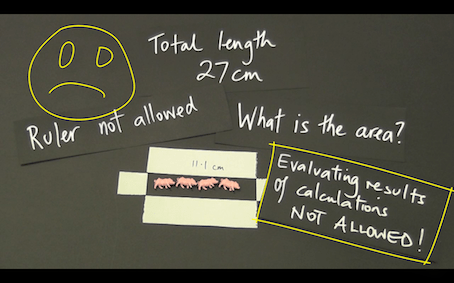This unit aims to provide a simple/useful way to thing about logarithms when first meting them.
We use two examples of “hard” to graph data (due to the extreme range in the values) to alert students to the idea of thinking about a number as its power, as opposed to its absolute value.
The rest of the unit aims to establish a way to think about calculating with logarithms that will set a sound foundation for later on and that builds on their knowledge of ‘indices’ from previous years.
Pigs, pens and mathematics is a two to four lesson, tried and proven, activity that moves students from measurement-thinking to functional-thinking with the help a simple but rarely used idea – do not evaluate a calculation.
A small, but authentic and enlightening use of electronic technology is made.
It would fit perfectly in a measurement topic at any of the years 8 to 11.
In this collection of resources you will find:
a) a two-part introductory video, that can be played to the class to kick things off,
b) one support video that shows “how to” do the technical stuff on the CG 20 AU,
c) one support video that explores the mathematical ideas that can be developed with the help of the technology,
d) one ‘task sheet’ for students to work on after watching the videos or being instructed by the teacher,
e) a complete ‘unit of work’ that allows students to consolidate the mathematical ideas and skills they have learned.
A selection of documents that share some nice ideas about exponential functions, trigonometric functions and a lovely context where both concepts come together.
Understanding the confidence interval for a population proportion (p) This video is a Zoom-recording of a virtual lecture/talk, in which the presenter shares a tried and proven way to present the ideas that underpin the confidence interval for a population …
Download a program that will creates the number of samples you desire, of a size you define from a normal population with standard deviation and mean you define.
This video and documents outline a 4 session course that aim to assist students to develop the optimal ways-of-thinking about the ideas that underpin calculus.
This short video shows how to determine a line of best fit for bivariate data via a scatterplot drawn using the Statistics app of a CASIO fx-CG series graphics calculator. CG20 AU and CG50 AU versions presented.
This short video shows how to convert angles measured in degrees minutes and seconds to and from angles expressed as decimals using the Run-Matrix app of a CASIO fx-CG series graphics calculator. CG20 AU and CG50 AU versions presented.
This video shows how to use a table of values to investigate the behaviour of a function, in particular when it takes a zero value, using the Table app of a CASIO fx-CG20 AU.
This short video shows how to generate a table of values, along with a plot of the table, for a function using the Table app of a CASIO fx-CG series graphics calculator. CG20 AU and CG50 AU versions presented.


